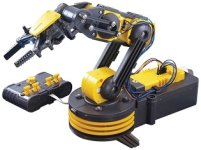Keep it Fast, Cool and Interesting
As dowthebow mentioned, the attention span of 8 to 10 year olds is short as I can attest to after 25 years as a scout leader, you need to have it fast paced and have lots of interaction to keep them on track. Kids love to talk to interested/ interesting adults. I’m working with an engineering society this week encouraging STEM during Professional Engineer’s Week among selected eighth graders (math and science geeks for the most part).
What seems to work is:
A brief slideshow/ discussion on “What is engineering?” and getting the audience to realize everything they physically use was the product of engineering (The alarm clock that woke them or their parents up this morning, the food they ate for breakfast was handled and cooked by engineered products, the desks they are sitting in, the clothes they wear, etc.) Let them come up with the list, write them on a board. If it goes slow, ask what is there favorite thing to do/ play with and bring it back around to how engineer’s made it possible, it would be a boring world if we didn’t have engineers.
Lead them into the common thread of what engineers do: They solve problems. Doing so makes money for a companies which is why engineers are well paid. Sometimes, they solve a problem that you didn’t even know you had such as personal computers and cell phone and they create a device that launches new industries.
In the slide show, print out a line on one of the slides that states,
“Engineers see things differently” (In flipped/mirrored text or at least backwards for a visual affect) then use the following:
A typical pro basketball player shoots 75% free throws and the coach is happy, if he shoots 90% he’s one of the best in the league and the coach is ecstatic. How would you feel if when you turned on your favorite toy, TV, etc. it
only worked 9 out of 10 times? Engineers work to make thing work each and every time, almost 100% of the time. Sometime they can’t accept any failures such as in space flights, water systems that recycle water that may have come from the sewer before you turn on the faucet, etc.
Explain the different types of engineers. Not just Mechanical, Electrical, Civil, Biomedical, etc. but what functions they perform: Design, Manufacturing, Testing, R&D, Sales, Service, Project, and of course Computer/ PLC hardware and software. Ask “Does anyone know an engineer?” and I’m betting a few hands will come up. And then ask them “What do they do?” This will make the other students aware that engineers are closer to them than they know and are everywhere. If no hands go up, point to yourself and say, “You now know one!” And many engineers don’t just stay engineers, they spring board after the bachelor’s degree and then go on to become lawyers (Patent especially, who better than an engineer to do this?), doctors, business leaders and other professions (if you can handle getting an engineering degree, you probably can succeed at anything you try). 60% of the fortune 500 CEOs started with an engineering degree that usually lead to a MBA.
Add in a hands on project or demonstration and you may hook some of them to become engineers. I remember an engineer father of a 6th grade classmate who cobbled up a Rube Goldberg machine that used potential, kinetic, chemical and thermal energy to cause a flash bulb to go off (Yep, it was back in the mid ‘60s: the finale was a weight falling off a table attached to a string wrapped around the shaft of a DC motor that then became a generator and made light). He then explained the changes in energy that occurred and you could hear a pin drop when he was talking.
You can also look at
http://discovere.org/ for more ideas and give the student the url so they can look it up later.






